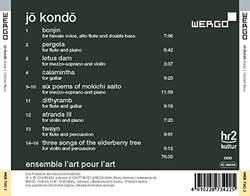| All Artists: Ensemble L'art pour L'art Title: Jo Kondo & Bonjin: Chamber Music Members Wishing: 1 Total Copies: 0 Label: Naxos of America, Inc. Release Date: 11/18/2016 Genre: Classical Styles: Chamber Music, Symphonies Number of Discs: 1 SwapaCD Credits: 1 |
Search - Ensemble L'art pour L'art :: Jo Kondo & Bonjin: Chamber Music
 | Ensemble L'art pour L'art Jo Kondo & Bonjin: Chamber Music Genre: Classical What happens if the composer and the listener are the same person? This is exactly what Jo Kondos way of composing implies. If the composer is to be nothing but a curious listener, he must be able to surprise himself. He m... more » |
Larger Image |
CD Details
Synopsis
Product Description
What happens if the composer and the listener are the same person? This is exactly what Jo Kondos way of composing implies. If the composer is to be nothing but a curious listener, he must be able to surprise himself. He must rid himself of all prior knowledge or intention. Born in Tokyo in 1947, Jo Kondo was influenced throughout his entire education almost exclusively by traditional Western art music. Like so many of his Western colleagues, he feels this to be both a limitation and the greatest challenge to the creative process. The music one grows up with is like a cage one has to break out of. The type of improvisation that Jo Kondo employs is only loosely related to improvisation as it is commonly understood. Kondo does not improvise using an instrument, but with music paper, note by note. I write down the first note, which can be anything, and then I try to listen to it again and again in my head until the second note appears. Then I write it down, and then I listen to these two notes again and again until the third note comes up. And then, repeating this process, I always go back to the top of the music to find the next note. That means that when I have 150 notes already in succession on my paper, I find number 151 by going back to the top of the piece and listening through from the top to the 150th note to find the next note. Thats what I mean by improvisation. - Jo Kondo All of Jo Kondos pieces have been written using this method. The result is a completely linear music that avoids any kind of obvious phrasing, melody, or motivic development, permitting the individual note to retain its own entity of life. Since even a musical line can endanger this fragile autonomy, Kondo distributes the notes among the various instrumental parts. This hocket technique, which has been used since the thirteenth century, demands enormous rhythmic virtuosity from the performers to avoid disrupting the organic unity of the extremely fragmented line. Thus, there is space left for the listener to create his own phrasing out of it.
